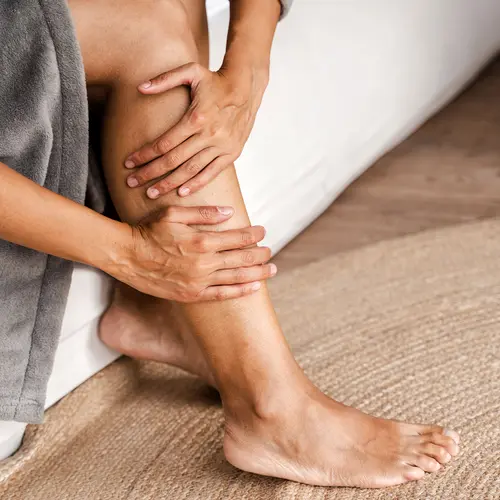If you have post-thrombotic syndrome (PTS), you may get pain, swelling, and other symptoms weeks or months after you've had deep vein thrombosis (DVT) -- a blood clot in a vein deep inside your body. There's no cure for PTS, but there are things you can do to help ease symptoms.
Blood clots in deep veins -- most often in your leg but sometimes in the arm -- can cause PTS when they damage small valves that help your blood flow toward your heart. The weakened valves leak and allow fluid to pool in your lower leg. Sometimes, the clot doesn't fully heal and blocks your blood flow.
Besides pain and swelling, PTS might cause symptoms like:
- Feelings of heaviness, achiness, itchiness, or tingling
- Cramps
- Skin changes, such as dryness, redness, darkening, or thickening
- Varicose veins
- Skin sores called ulcers
Tips to Manage PTS
To feel your best with PTS, you may need to use several therapies and make some lifestyle changes.
Wear a compression stocking. Elastic compression stockings are the main treatment for PTS. These tight stockings help your leg muscles move fluid upward to ease swelling and pain.
You can buy them over-the-counter, but your doctor may prescribe a stronger stocking. These tighter garments apply more pressure to help blood in your veins flow in the right direction. If PTS affects your arm, you can wear a compression sleeve that works the same way.
You may need to wear the stocking for months or years to control your symptoms.
Compression stockings come in a variety of sizes, materials, and colors. Staff at a medical supply store can measure you and show you options that fit your leg and your personal style.
If you find the compression stockings are uncomfortable, ask your doctor if it's OK to use a knee-length stocking. It might be easier to put on and more comfortable than one that rises to your thigh.
Try to get fitted in the morning, when your leg is least swollen. Also, put your stocking on first thing in the morning, when swelling is lowest.
Some other tips to make sure your stocking is comfortable:
- Wear your stocking only on the limb with PTS and remove it at night.
- Start out wearing it only a few hours a day, gradually increasing the amount of time.
- Follow the cleaning directions on the label to prevent shrinkage and damage.
- While the stocking is on, don't cut it, roll it, or fold it down.
- Buy a new stocking every 3 to 6 months.
It's a good idea to use rubber gloves for a better grip when you put on the stocking. You can also use a stocking aid to extend your reach if it's hard for you to bend down.
Moisturize regularly. This can help you prevent ulcers in your skin in the areas affected by PTS. Ask your doctor which moisturizers are best for you. They may suggest nonirritating lotions like petroleum jelly or barrier creams with zinc oxide.
Raise your leg. Do this a few times throughout the day while seated or lying down to curb pain and swelling.
Make lifestyle changes. Your symptoms may get better if you:
- Lose weight if you're obese.
- Walk every day to improve your muscle strength and heart health.
- Do exercises that build stronger, more flexible leg muscles.
- Join an instructor-led class that includes exercises that get your heart pumping and strengthen your calf muscles.
- Limit your time in high temperatures, which can trigger swelling and feelings of heaviness.
Options for Hard-to-Treat PTS
If your PTS symptoms still get in the way of your daily life after you've taken steps to manage them, your doctor may suggest other treatments, such as:
Compression devices. Products called "venous-return assist devices" are battery-powered so that you can move around while you wear one.
If you have a lot of pain or swelling, your doctor may suggest an "intermittent pneumatic compression" device. It has sleeves that slip over your calf, where they tighten and release in 20- to 60-second cycles. You sit or lie down during treatment, which is usually done several times a day for 20 to 30 minutes.
Corticosteroids.Steroid creams or ointments may ease your skin symptoms.
Ulcer therapies. Compression is the main treatment for ulcers caused by PTS. Your doctor also may prescribe special dressings for your skin and a medication called pentoxifylline to improve blood and oxygen flow to healing tissues.
Surgery. If your symptoms are severe, your doctor may talk to you about your options for surgery. These can include operations to repair damaged valves, remove a blockage, or place a stent -- a tiny mesh tube that helps keep veins open.

